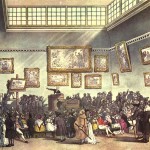 Negotiating Art: Dealers and Museums (London, 1-2 Apr 16)
Negotiating Art: Dealers and Museums (London, 1-2 Apr 16)
The National Gallery, London, April 1 – 02, 2016
Deadline: Sep 18, 2015
Negotiating Art: Dealers and Museums.
This two-day conference on the relations between art dealers and museums, organised by the National Gallery in collaboration with the University of Manchester and the University of Liverpool, will be held at the National Gallery, London.
This joint conference, which has its origins in the acquisition of the Thos. Agnew & Sons archive by the National Gallery, aims to explore the relationship between art dealers and museums, in the UK and worldwide, and across a wide chronological period. Although there will be a focus on the London and British art market in the late 19th century, we wish to include papers that span the period 1855-2015 and across a range of geographical areas, in order to establish connections and assess contrasts between places and periods.
Many fundamental topics are implicated by the subject of this conference. For example, the relationship between consumption and culture; the creation, separation and ethical remits of professional specialisms; the nature and role of art institutions; and the multifaceted – and conflicting – roles of art collecting. We have singled out four key themes, which we envisage will comprise discrete conference sessions, and we invite paper proposals that engage with some aspect of them:
1 – Mechanics of the relationship: How did the relationships between dealers and art museums work? Were these business relationships, advisory roles, or both? Which sources can we use to establish such relationships? Can quantitative evidence like pricing be used to illuminate these relationships further? Can any shifts in these dynamics be identified or measured over a geographical or chronological range?
2 – Biographies: Who were/are the main dealers associated with art museums? Can the personal and institutional biographies of specific dealers, agents, curators and other associated players assist in the reconstruction of the dealer-museum relationship, either in the historical or contemporary domains?
3 – Collaboration and conflict: How close was/is the relationship between various dealers and art museums? To what extent can these relationships be construed as successful or otherwise? Are there examples of conflict, such as failed deals, arguments over pricing or the breakdown of relationships? How were successful cases, such as acquisitions mediated by dealers, negotiated? What happens when dealers are in competition with each other? And what happens when museums are in competition with each other?
4 – Works: How can case studies of single artworks or groups of pieces help us to understand better the model of dealer-museum interaction? How do the previous histories of works, their provenance, and the manner of their acquisition (e.g. private treaty or auction sale) affect their afterlife in the museum?
How to submit:
Papers should be a maximum of 20 minutes in length, and preference will be given to proposals which stimulate dialogue and engage with broader topics. Please send enquiries and proposals of no more than 300 words, indicating which session your paper relates to, by 18 September 2015, to research.centre@ng-london.org.uk (marked for the attention of Alan Crookham).
Papers will be selected by 18 October 2015. Some financial assistance with travel expenses for speakers may be available (subject to grant approval).

Leave a Reply
You must be logged in to post a comment.